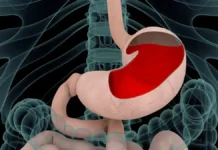Introduction
Abdominal myofascial pain syndrome, a condition characterized by localized muscle pain and tender trigger points in the abdominal region, remains a major concern affecting the quality of life of many individuals. The varied symptoms, often linked to excessive muscle tension, can lead to persistent discomfort and sometimes functional digestive disorders.
Faced with this complexity, osteopathy presents itself as a holistic therapeutic approach, emphasizing precise manual techniques aimed at relieving muscular tension, improving mobility, and restoring physical balance. This individualized approach, combined with advice on posture, exercise, and stress management, provides a comprehensive perspective for the treatment of abdominal myofascial pain syndrome.
Osteopathy works to understand the underlying mechanisms of the syndrome, in particular by evaluating the mobility of the joints, the quality of the soft tissues and the overall posture of the patient. Manual techniques, such as myofascial release, joint mobilization and specific stretches, are used to release muscle tension and restore flexibility. The holistic approach of osteopathy also considers psychosocial aspects, such as stress and lifestyle habits, which can contribute to the manifestation of the syndrome.
When exploring this condition in detail, it is essential to recognize its impact on individuals’ daily lives. Persistent abdominal pain can impair sleep quality, affect the ability to carry out daily activities, and lead to a decreased appetite. Functional digestive disorders, such as bloating and bowel movement disorders, add an additional dimension to the complexity of the condition.
Osteopathic diagnostic methods involve a thorough evaluation of medical history, specific symptoms, and detailed physical examinations. Trigger points, sensitive and tense areas in the muscles, are identified to guide treatment. The osteopath takes the whole individual into account, seeking to understand contributing factors to personalize the treatment plan.
Osteopathic treatment approaches for abdominal myofascial pain syndrome aim to relieve pain, improve muscle function, and restore structural balance. Practical advice on posture, ergonomics, and adopting a suitable exercise routine contribute to the long-term management of the condition. Prevention, for its part, involves raising awareness of lifestyle habits favorable to muscular health and stress management.
Main Characteristics of Abdominal Myofascial Pain Syndrome
Abdominal Myofascial Pain Syndrome manifests with distinct characteristics that make it a condition in its own right, requiring in-depth understanding for proper diagnosis and treatment. At the heart of this condition are localized muscle pain and tender trigger points in the abdominal area. These points, often palpable, are areas of heightened muscular tension which can trigger pain when stimulated.
Symptoms of the syndrome vary, but excessive muscle tension is frequently at the center of the manifestations. This tension can lead to persistent discomfort or even chronic pain, affecting the quality of life of affected individuals. The abdominal muscles, when used abnormally, may present contracted and sensitive areas, contributing to symptoms of discomfort.
The pain experienced with this syndrome can be described as deep, stabbing or shooting, often associated with a feeling of muscle stiffness. These painful sensations can extend to a defined area of the abdomen, creating a significant impact on the ability to carry out daily activities. Pain can also be exacerbated by palpation of trigger points, highlighting their crucial role in diagnosis.
The symptoms aren’t just limited to pain. Abdominal Myofascial Pain Syndrome is often associated with functional digestive disorders. Muscle imbalances in the abdominal area can disrupt the normal functioning of the digestive system, leading to symptoms such as bloating, abdominal pain, or changes in bowel habits. This combination of symptoms reinforces the complexity of the condition, requiring a holistic approach for effective management.
To diagnose the syndrome, health professionals, particularly osteopaths, carry out a careful assessment. The patient’s medical history, description of symptoms, and a detailed physical examination are key elements of the diagnostic process. The precise identification of trigger points, combined with an assessment of muscle and joint mobility, allows an accurate diagnosis to be established.
The treatment of Abdominal Myofascial Pain Syndrome is based on an individualized approach, often centered on osteopathy. Manual techniques, such as myofascial release, joint mobilization, and specific stretching, are used to release muscle tension, improve mobility, and restore physical balance. Stress management and practical advice on posture and exercise are also an integral part of the treatment.
- Localized Pain: The pain associated with this syndrome is usually localized in the abdominal area, and it can vary in intensity, from mild discomfort to severe, throbbing pain.
- Trigger Points: Much like other forms of myofascial pain, abdominal syndrome is often characterized by trigger points. These are specific areas in the muscles where light pressure can trigger or intensify pain.
- Muscle Stiffness: The abdominal muscles can become tight and rigid due to prolonged contraction, contributing to pain and restriction of movement.
- Referred Pain: It is common that the pain associated with abdominal myofascial pain syndrome can radiate to other areas of the body, which is called referred pain. For example, the pain may spread to your lower back or sides.
- Impaired Digestive Function: Some individuals may experience disturbances in digestive function, such as bloating, mild gastrointestinal upset, or increased sensitivity in the abdominal area.
- Triggering Factors: Abdominal myofascial pain syndrome can be triggered by physical trauma, emotional tension, postural disorders, or repetitive movements.
- Difficult Diagnosis: Diagnosing abdominal myofascial pain syndrome can be tricky due to the complexity of the symptoms and their similarity to other abdominal conditions. It often requires a thorough evaluation by medical professionals.
Understanding these characteristics provides a basis for approaching abdominal myofascial pain syndrome holistically, integrating treatment approaches such as physical therapy, stress management, and sometimes, pharmacological interventions to relieve pain and restore normal abdominal function.
Main Characteristics of Abdominal Myofascial Pain Syndrome (AMPS)
Understanding the core characteristics of Abdominal Myofascial Pain Syndrome (AMPS) is essential for accurate diagnosis and effective treatment. Below are the primary features of this condition:
1. Localized Pain and Trigger Points
One of the hallmark features of AMPS is localized pain caused by hyperirritable spots within the abdominal muscles, known as trigger points.
- Trigger Points:
- These are small, tight knots in the muscle fibers, often tender to touch.
- Pressure on these points can reproduce the pain reported by the patient.
- They may refer pain to other areas, complicating diagnosis.
- Pain Characteristics:
- Often described as deep, aching, or sharp.
- Can be spontaneous or triggered by palpation or specific movements.
- Localized pain may become chronic if untreated, significantly affecting quality of life.
2. Muscle Stiffness and Referred Pain
AMPS is frequently accompanied by muscle stiffness and referred pain, which can extend beyond the abdominal area.
- Muscle Stiffness:
- Persistent tension in the abdominal muscles can limit flexibility and movement.
- This stiffness often affects posture, making simple tasks uncomfortable or painful.
- Referred Pain:
- Trigger points can cause pain to radiate to other areas, such as:
- The lower back.
- Hips or pelvic region.
- Sides of the abdomen.
- Referred pain may mimic symptoms of other conditions, such as gastrointestinal or gynecological disorders, complicating diagnosis.
- Trigger points can cause pain to radiate to other areas, such as:
3. Functional Digestive Disorders
AMPS often overlaps with functional digestive issues, adding another layer of complexity to its presentation.
- Digestive Symptoms:
- Bloating, abdominal discomfort, and changes in bowel habits (e.g., constipation or diarrhea).
- Increased sensitivity in the abdominal region.
- Digestive disturbances may be exacerbated by stress or dietary habits.
- Muscle-Digestive Connection:
- Muscle imbalances and tension in the abdominal region can interfere with normal digestive processes.
- The diaphragm and other abdominal structures may be affected, contributing to symptoms like acid reflux or a sensation of fullness.
Key Takeaways
- Localized Pain and Trigger Points: Specific areas of muscle tension that cause pain, often radiating to other regions.
- Muscle Stiffness and Referred Pain: Tense abdominal muscles leading to restricted movement and pain in surrounding areas.
- Functional Digestive Disorders: Overlapping symptoms affecting digestion and contributing to the overall discomfort of AMPS.
Recognizing these characteristics is vital for developing an effective treatment plan that addresses both the localized and systemic manifestations of AMPS. A holistic approach, such as osteopathic care, can target these issues to relieve pain, improve mobility, and restore overall function.
Location and Impact of Trigger Points
The location of abdominal myofascial points is crucial to understanding Abdominal Myofascial Pain Syndrome and its specific pain manifestations. These points, often palpable by healthcare professionals, are areas in the abdominal muscles where muscle tension is exacerbated. Their stimulation triggers or intensifies the pain characteristic of this syndrome. Abdominal myofascial points are usually located along the midline of the abdomen, often in the rectus abdominis and oblique muscles.
The main trigger point is frequently found in the upper abdomen, just below the xiphoid process of the sternum. Pressure on this point can cause intense pain, often described as a burning or stinging sensation. It is associated with symptoms such as difficulty breathing, epigastric pain and sometimes manifestations referred to other areas of the body.
Another common point is located in the lower region of the abdomen, near the iliac crest. Stimulation of this point can cause pain radiating downward, sometimes confused with digestive or gynecological problems. The oblique muscles, particularly sensitive in this area, can contribute to the manifestation of pain.
The region of the rectus muscles, especially in its middle part, is also home to sensitive myofascial points. Pain associated with these points may be felt as constant tension, often affecting the ability to stand up straight or perform bending movements.
The transversus abdominis muscles may also be involved, with myofascial points located more deeply. The pain associated with these points can be felt as a diffuse discomfort, often difficult to localize precisely.
The manifestation of specific pain related to the stimulation of these points is often described as referred pain, that is, the pain felt in these points can radiate to other areas of the body. For example, stimulation of the upper abdominal myofascial point can cause pain in the thoracic region or shoulders. This complexity in the location and manifestation of pain makes the diagnosis of Abdominal Myofascial Pain Syndrome a challenge that requires clinical expertise.
Health professionals, particularly osteopaths, use precise manual techniques to identify and treat these myofascial points. Myofascial release, joint mobilization, and specific stretches are an integral part of the treatment aimed at relieving muscle tension, improving mobility, and reducing pain associated with these tender points.
List of abdominal trigger points
- Upper Point (under the xiphoid process):
- Location: Just below the xiphoid process of the sternum.
- Manifestations of Pain:
- Severe pain.
- Burning sensation.
- Breathing difficulties.
- Lower Point (near the iliac crest):
- Location: In the lower abdomen, near the iliac crest.
- Manifestations of Pain:
- Pain radiating downward.
- Possible confusion with digestive or gynecological problems.
- Points in the Rectus Muscles (middle part):
- Location: Middle part of the rectus muscles.
- Manifestations of Pain:
- Constant tension.
- Discomfort when bending or standing.
- Points in the Transverse Abdomen Muscles:
- Location: Deeper in the transverse muscle region.
- Manifestations of Pain:
- Diffuse discomfort.
- Difficulty locating precisely.
- Points in the Oblique Muscles:
- Location: Mainly in the oblique muscles.
- Manifestations of Pain:
- Pain radiating in different directions.
- Increased sensitivity during palpation.
- Perimbilical point:
- Location: Around the umbilical region.
- Manifestations of Pain:
- Feeling of pulling or twisting around the navel.
- Pain on pressure or palpation.
- Points in the Pelvic Muscles:
- Location: At the level of the pelvic muscles, near the pubic bone.
- Manifestations of Pain:
- Pain in the pelvic region.
- Possible urinary or gynecological disorders.
- Points in the Lumbosacral Muscles:
- Location: In the lumbosacral region, near the spine.
- Manifestations of Pain:
- Lower back pain.
- Stiffness or discomfort when moving.
- Points in the Ileo-Psoas Muscles:
- Location: Near the ileopsoas muscles, in the groin area.
- Manifestations of Pain:
- Deep pain in the groin or hip.
- Possible difficulty lifting the leg.
- Perirenal point:
- Location: Near the kidneys, at the level of the flank.
- Manifestations of Pain:
- Pain in the region of the kidneys.
- Feeling of tension or pressure.
- Point in the Spinal Erector Muscles:
- Location: Near the spine, along the erector spinae muscles.
- Manifestations of Pain:
- Pain in the lumbar region.
- Stiffness or discomfort during back flexion or extension.
- Points in the Intertransverse Muscles:
- Location: Between the vertebrae, at the level of the intertransverse muscles.
- Manifestations of Pain:
- Pain localized between the vertebrae.
- Feeling of stiffness or blockage.
- Point in the Transverse Abdomen Muscle:
- Location: Near the transversus abdominis muscle, deep in the abdominal wall.
- Manifestations of Pain:
- Deep embarrassment.
- Pain during muscle contraction.
- Points in the Costal Muscles:
- Location: Along the ribs, in the costal muscles.
- Manifestations of Pain:
- Chest pain associated with breathing.
- Increased sensitivity when palpating the costal muscles.
- Point in the Diaphragm:
- Location: At the level of the diaphragm, under the ribs.
- Manifestations of Pain:
- Epigastric pain.
- Breathing difficulties.
- Point in the Transverse Abdomen Muscles (Lower Part):
- Location: In the lower part of the transversus abdominis muscles.
- Manifestations of Pain:
- Discomfort in the pelvic region.
- Feeling of pressure or pulling.
- Point in the Adductor Muscles of the Thigh:
- Location: Near the groin, in the adductor muscles of the thigh.
- Manifestations of Pain:
- Pain in the groin area.
- Possible hip mobility problems.
- Point in the Gracili Muscles:
- Location: In the gracilis muscles, on the inside of the thigh.
- Manifestations of Pain:
- Deep pain in the inner thigh.
- Discomfort while walking or bending the leg.
- Point in the Quadratus Lumbar Muscles:
- Location: Near the quadratus lumborum muscles, in the lumbar region.
- Manifestations of Pain:
- Pain localized in the lumbar region.
- Increased sensitivity during twisting movements.
- Point in the Gluteus Maximus Muscle:
- Location: In the gluteus maximus muscle, on the outside of the hip.
- Manifestations of Pain:
- Pain on side of hip.
- Possible mobility issues.
- Point in the Hamstring Muscles:
- Location: Near the hamstring muscles, on the back of the thigh.
- Manifestations of Pain:
- Pain in the back of the thigh.
- Increased sensitivity when bending the leg.
- Point in the Pyramidal Muscle:
- Location: In the piriformis muscle, in the pelvic region.
- Manifestations of Pain:
- Deep pain in the pelvic region.
- Discomfort during pelvic movements.
- Point in the Obturator Internus Muscle:
- Location: Near the obturator internus muscle, in the pelvic region.
- Manifestations of Pain:
- Deep pain in the pelvic region.
- Possible hip mobility problems.
- Point in the Psoas Muscle:
- Location: Near the psoas muscle, in the lumbar region.
- Manifestations of Pain:
- Deep pain in the lumbar region.
- Increased sensitivity during bending movements.
- Point in the Interspinous Muscles:
- Location: Between the spines, along the spine.
- Manifestations of Pain:
- Pain along the spine.
- Discomfort during rotational movements.
Causes and Triggers
The causes and triggering factors of Abdominal Myofascial Pain Syndrome are multiple, making the understanding of this painful condition more complex. At the heart of this syndrome is excessive muscle tension in the abdominal region, and several elements can contribute to its triggering. Physical trauma, such as injuries or accidents, can induce abnormal muscle contractions, creating a breeding ground for the syndrome to develop.
Emotional tensions and stress also represent significant factors in the emergence of the syndrome. The muscles in the abdominal region often react to psychological tension by contracting, which can lead to a build-up of prolonged muscle tension. Inadequate postural habits, whether linked to working conditions or daily activities, can contribute to muscular overuse and encourage the onset of the syndrome.
Sleep disorders and chronic fatigue are also factors to take into account. Insufficient or poor quality sleep can disrupt normal muscle recovery, thereby increasing muscle sensitivity and promoting the development of the syndrome. Digestive disorders, such as food intolerance or gastrointestinal issues, can also play a role in amplifying muscle tension in the abdominal area.
Genetic factors should not be neglected, as certain hereditary predispositions can influence an individual’s susceptibility to developing this syndrome. Women also appear to be more predisposed than men, although the exact mechanisms of this predisposition are not yet completely understood.
Accurate identification of triggering factors is essential to guide a personalized treatment plan. In-depth assessment by health professionals, such as osteopaths, often involves a detailed analysis of medical history, history of physical trauma, lifestyle habits, and specific assessments of muscle tension.
Management and prevention of Abdominal Myofascial Pain Syndrome involves a holistic approach. Therapeutic interventions, such as osteopathy, focus on releasing muscular tension, restoring mobility, and physical balancing. Addressing psychological factors, such as stress, is also crucial, often involving stress management approaches and lifestyle advice.
- Physical Trauma:
- Trauma, such as sports injuries, car accidents, or falls, can lead to muscle tension in the abdominal area, contributing to the development of myofascial pain syndrome.
- Emotional Stress:
- Chronic emotional stress can cause widespread muscle tension, including in the abdominal area. Psychological stresses can amplify the symptoms of myofascial pain syndrome.
- Postural Disorders:
- Poor posture, whether at work, prolonged sitting, or while sleeping, can create muscular imbalances in the abdominal area, thus promoting the development of painful trigger points.
- Repetitive Movements:
- Repetitive movements, often associated with certain occupations or activities, can place constant pressure on the abdominal muscles, contributing to the development of myofascial pain.
- Digestive disorders
- Certain gastrointestinal disorders, such as irritable bowel syndrome, can be associated with abdominal myofascial pain syndrome, creating a complex interplay between muscle pain and digestive issues.
- Trauma, such as sports injuries, car accidents, or falls, can lead to muscle tension in the abdominal area, contributing to the development of myofascial pain syndrome.
- Gynecological Disorders:
- Gynecological conditions, such as endometriosis, can also contribute to abdominal myofascial pain in some women, exacerbating symptoms in this region.
- Eating habits :
- Improper dietary habits, such as excessive consumption of inflammatory foods, can potentially contribute to the abdominal discomfort associated with myofascial pain syndrome.
- Bad Breathing Habits:
- Irregular breathing or breathing thoracically rather than diaphragmatic can place increased pressure on the abdominal muscles, promoting tension and pain.
- Genetic Factors:
- Genetic predispositions may make some individuals more susceptible to the development of muscle disorders and trigger points in the abdominal area.
- Sedentary lifestyle:
- A sedentary lifestyle can contribute to muscle stiffness and weakness in the abdominal area, thereby promoting the development of myofascial pain.
- Gynecological conditions, such as endometriosis, can also contribute to abdominal myofascial pain in some women, exacerbating symptoms in this region.
Symptoms and Manifestations
Abdominal Myofascial Pain Syndrome manifests through a diverse range of symptoms and manifestations, creating a complex and often debilitating clinical picture for affected individuals. At the heart of these manifestations is localized muscle pain in the abdominal region, characterized by sensitive trigger points. This pain can vary in intensity, from mild, intermittent pain to more severe, persistent sensations.
Trigger points, often palpable by healthcare professionals, are specific areas in the abdominal muscles where muscle tension is exacerbated. Stimulation of these points can trigger or worsen pain, thus constituting an important diagnostic criterion for the syndrome. The abdominal muscles themselves may also exhibit noticeable stiffness and tension, contributing to the general discomfort experienced by affected individuals.
In addition to pain, the syndrome is often associated with functional digestive disorders. Muscle imbalances in the abdominal area can disrupt the normal functioning of the digestive system, leading to symptoms such as bloating, abdominal pain, changes in bowel habits, and sometimes even problems digesting food. These manifestations add an additional dimension to the complexity of the syndrome, requiring a holistic approach for comprehensive management.
Symptoms of Abdominal Myofascial Pain Syndrome can also impact sleep quality. Constant pain, combined with difficulty finding a comfortable position, can lead to sleep disturbances, contributing to fatigue and a general decline in quality of life. Some individuals may also experience increased abdominal muscle sensitivity to touch, making pain worse with light touches.
Psychologically, the chronic manifestation of pain can lead to deleterious effects, such as anxiety and depression. The restrictions imposed by constant pain can affect daily activities, leading to decreased quality of life and altered mood. Managing the psychological aspects of the syndrome is therefore often integrated into overall therapeutic approaches.
Diagnosis of Abdominal Myofascial Pain Syndrome is based on a thorough assessment of symptoms, medical history, and detailed physical examinations. Healthcare professionals, such as osteopaths, use this information to identify trigger points, assess muscle and joint mobility, and confirm the diagnosis.
Management of the syndrome aims to relieve pain, improve muscle function and restore physical balance. Therapeutic approaches, notably osteopathy, involve specific manual techniques aimed at releasing muscular tension, improving mobility, and restoring the quality of life of affected individuals. Stress management, advice on posture and adopting a suitable exercise routine are also an integral part of the treatment.
- Localized Pain:
- Pain is one of the predominant symptoms of abdominal myofascial pain syndrome. It is often described as a deep, stabbing pain or burning sensation located in the abdominal area.
- Sensitivity to Trigger Points:
- The presence of trigger points is a distinctive feature. These specific areas in the abdominal muscles become sensitive to touch, and light pressure can trigger or intensify the pain.
- Muscle Stiffness:
- The abdominal muscles can become tight and stiff, contributing to limited movement and a general feeling of discomfort.
- Referred Pain:
- The pain associated with abdominal myofascial pain syndrome may radiate to other areas of the body, such as the lower back, sides, or upper thigh. This referred pain can make the diagnosis more complex.
- Functional Digestive Disorders:
- Some individuals may experience functional digestive disorders, such as bloating, excessive gas, disturbances in intestinal transit, or increased sensitivity in the abdominal area.
- Chronic Muscle Tension:
- Chronic muscle tension in the abdominal area can lead to a constant feeling of discomfort, which can be exacerbated by certain activities or positions.
- Muscle fatigue :
- Muscle fatigue may be present due to prolonged contraction of the abdominal muscles, even during light activities.
- Pain Cycles:
- Some individuals may experience cycles of pain, with periods of exacerbation followed by periods of relative relief. These cycles can be influenced by factors such as stress, physical activity, or eating habits.
- Discomfort when sitting or lying down:
- Pain and discomfort may intensify with prolonged sitting or lying down, which may affect sleep quality.
- Impact on Quality of Life:
- The combination of these symptoms can have a significant impact on quality of life, affecting daily activities, work, and social interactions.
Diagnosis of Abdominal Myofascial Pain Syndrome
- History and Medical History Assessment:
- Healthcare professionals begin by taking a detailed history to understand the patient’s medical history, including any physical trauma, postural habits, stress levels, or gastrointestinal issues.
- General Physical Examination:
- A general physical examination is performed to assess posture, mobility, and detect any structural or muscular abnormalities.
- Palpation of the Abdominal Muscles:
- Professionals, including osteopaths, use palpation to assess muscle tension in the abdominal area. This technique makes it possible to identify areas of sensitivity and locate possible trigger points.
- Finding Trigger Points:
- Identifying trigger points is crucial. These specific areas in the abdominal muscles are often responsible for the characteristic pain. Pressure on these points may reproduce the pain reported by the patient.
- Exclusion of other Conditions:
- Since the symptoms of abdominal myofascial pain syndrome may be similar to other abdominal conditions, healthcare professionals work to rule out other potential causes, such as gastrointestinal problems, infections, or visceral disorders. .
- Assessment of Joint Mobility and Muscle Chains:
- Osteopaths also focus on evaluating joint mobility and muscle chains related to the abdominal region. Imbalances in these aspects can contribute to symptoms.
- Neurological Examination:
- A neurological exam may be performed to assess nerve function and rule out other conditions involving the nervous system.
- Medical Imaging (if necessary):
- In some cases, imaging tests such as X-rays or an MRI may be recommended to rule out structural causes or check for other medical conditions.
- Healthcare professionals begin by taking a detailed history to understand the patient’s medical history, including any physical trauma, postural habits, stress levels, or gastrointestinal issues.
Osteopathic Treatment of Abdominal Myofascial Pain Syndrome
Osteopathy offers a holistic, non-invasive approach to the treatment of abdominal myofascial pain syndrome. Osteopaths use various manual techniques aimed at relieving muscle tension, improving mobility, and promoting the patient’s overall well-being. Here is an overview of osteopathic approaches often used to treat this condition:
- Precise Palpation of Trigger Points:
- The osteopath uses palpation to precisely locate the trigger points responsible for the pain. Gentle pressure on these specific areas allows you to assess the muscle reaction and better understand the source of the pain.
- Myofascial Release Techniques:
- Myofascial release techniques aim to relax tight muscles and release adhesions in fascial tissues. This can be done using slow movements, gentle pressure, and specific manipulations to release restrictions.
- Stretching and Joint Mobilization:
- Specific stretches and joint mobilizations may be prescribed to improve flexibility and mobility of the abdominal region. These techniques aim to reduce muscle stiffness and restore full range of motion.
- Diaphragmatic Release Techniques:
- Given the importance of the diaphragm in abdominal function, osteopaths can use diaphragmatic release techniques to improve breathing, relax surrounding muscles, and promote overall balance.
- Education on Posture and Lifestyle Habits:
- Osteopaths provide advice on proper posture during daily activities, at work, and even while sleeping. Lifestyle education, including stress management and nutritional counseling, is often integrated into the treatment plan.
- Personalized Therapeutic Exercises:
- Specific therapeutic exercises may be recommended to strengthen the abdominal muscles, improve stability, and prevent recurrence of symptoms. These exercises are usually tailored to the patient’s individual needs.
- Global approach :
- Osteopathy takes a whole-patient approach, considering not only local symptoms, but also contributing factors such as stress, posture, and musculoskeletal imbalances in other parts of the body.
- Postural Rehabilitation:
- Postural reeducation can be an integral part of treatment. Osteopaths work with patients to correct postural imbalances and promote optimal posture in all daily activities
Complementary Approaches in Osteopathy
- Adapted Nutrition:
- A balanced and appropriate diet can help relieve symptoms. Osteopaths can provide personalized nutritional advice, emphasizing anti-inflammatory and muscle health-promoting food choices.
- Nutraceutical Supplements:
- Certain supplements, such as omega-3 (essential fatty acids with anti-inflammatory properties) or magnesium supplements, may be recommended to support muscle health and reduce inflammation.
- Stress management :
- Chronic stress can contribute to muscle tension and worsen symptoms. Stress management techniques, such as meditation, deep breathing, or yoga, can be taught to promote relaxation and reduce the stress response.
- Biofeedback:
- Biofeedback is a method that allows the patient to become aware of physiological responses to pain and learn to regulate them. This may be helpful in decreasing muscle tension associated with the syndrome.
- Muscle Relaxation Techniques:
- Progressive muscle relaxation exercises or other relaxation techniques may be recommended to consciously release muscle tension in the abdominal area.
- Hydrotherapy:
- Using hot or cold compresses can help relieve pain and muscle tension. Osteopaths can advise on the appropriate application of these methods.
- Gentle Exercise Programs:
- Gentle exercise programs, such as Pilates or adapted yoga, can be incorporated to gradually strengthen muscles while improving flexibility.
- Lifestyle Education:
- Education on healthy lifestyle habits, including adequate sleep, hydration, and management of daily activities, is often incorporated to support the healing process.
Case Studies
Case Study 1:
Patient Name: Marie D.
Symptoms: Marie suffered from persistent abdominal pain, muscle stiffness, and functional digestive disorders. Symptoms were exacerbated by prolonged sitting.
Osteopathic Approach: A thorough assessment revealed trigger points in the abdominal muscles associated with poor posture at work. Treatment included myofascial release techniques, specific stretches, and advice on ergonomics.
Results: After several osteopathic sessions and the integration of advice on posture at work, Marie experienced a significant reduction in abdominal pain and muscle stiffness. Her digestive issues improved, and she learned specific exercises to maintain muscle health.
Case Study 2:
Patient Name: Marc G.
Symptoms: Marc had recurring abdominal pain, with referred pain to his lower back. He also had a history of sports trauma.
Osteopathic Approach: The assessment identified trigger points in the abdominal muscles and joint restrictions in the lumbar region. Treatment included myofascial release techniques, joint mobilizations, and targeted strengthening exercises.
Results: After a treatment plan including several osteopathic sessions and regular practice of recommended exercises, Marc reported a significant reduction in abdominal pain and back pain. He also noted an improvement in his overall mobility.
Case Study 3:
Patient Name: Sarah L.
Symptoms: Sarah had chronic abdominal pain with increased sensitivity to trigger points. She had a history of emotional stress.
Osteopathic Approach: The assessment highlighted trigger points in the abdominal muscles associated with stress-related tension. Treatment included muscle relaxation techniques, stress management counseling, and stretching.
Results: After several osteopathic sessions focused on stress management and muscle relaxation, Sarah reported a significant reduction in abdominal pain. She learned self-relaxation techniques to maintain her emotional and physical well-being.
FAQs About Questions about the Syndrome
Q1: What is abdominal myofascial pain syndrome?
Abdominal myofascial pain syndrome is a condition characterized by localized muscle pain, tender trigger points, and sometimes functional digestive disturbances. It results from excessive tension of the muscles and fascial tissues in the abdominal region.
Q2: How is abdominal myofascial pain syndrome diagnosed?
Diagnosis is based on a thorough assessment of the patient’s history, physical examinations, and identification of trigger points by a healthcare professional, including osteopaths. Additional tests may be performed to rule out other possible conditions.
Q3: What are the common symptoms of abdominal myofascial pain syndrome?
Symptoms include localized abdominal pain, trigger point tenderness, muscle stiffness, referred pain, functional digestive disturbances, and muscle fatigue.
Q4: How can osteopathy help treat this syndrome?
Osteopathy uses manual approaches, such as myofascial release, stretching, and joint mobilizations, to relieve muscle tension, improve mobility, and promote healing. It also includes advice on posture, exercise, and stress management.
Q5: How many osteopathic sessions are generally necessary?
The frequency of sessions varies depending on the severity of symptoms and individual response to treatment. In many cases, an initial plan of a few sessions, followed by regular assessment, is recommended. Treatment is often tailored to the specific needs of each patient.
Q6: Are osteopathic treatments painful?
Osteopathic techniques are generally well tolerated, and the osteopath adapts the intensity according to the patient’s sensitivity. It is common to experience slight discomfort during treatment, but most patients find the sessions beneficial and calming.
Q7: Are the treatment results lasting?
Results vary from individual to individual, but many patients experience significant improvement in pain and function after osteopathic treatment. Advice on posture, exercise, and lifestyle can help maintain long-term benefits.
Q8: Are there any specific recommendations for the prevention of abdominal myofascial pain syndrome?
Prevention involves adopting good posture, managing stress, regular exercises to strengthen the abdominal muscles, and taking dietary factors into account. Osteopaths can provide personalized advice to minimize the risks of developing the condition.
Conclusion
In conclusion, abdominal myofascial pain syndrome is a complex condition that can have a significant impact on individuals’ quality of life. The varied symptoms, such as abdominal pain, trigger point tenderness, and digestive disorders, require a holistic approach to diagnosis and treatment. Osteopathy is emerging as an effective therapeutic option, with an emphasis on manual techniques such as myofascial release, stretching, and joint mobilization.
The individualized approach of osteopathy makes it possible to precisely target trigger points, release muscular tension, and improve mobility, thus contributing to the relief of symptoms. Advice on posture, exercise, nutrition, and stress management completes the treatment, promoting an integrated approach for optimal recovery.
Case studies and testimonials illustrate the success of osteopathy in managing the syndrome, showing how a personalized approach can lead to significant improvement in pain and function. By answering frequently asked questions, we have also clarified aspects related to the diagnosis, treatment, and prevention of this condition.
In short, osteopathy is positioned as a comprehensive therapeutic option for individuals suffering from abdominal myofascial pain syndrome, offering a path to lasting symptom relief and restoration of quality of life.

























